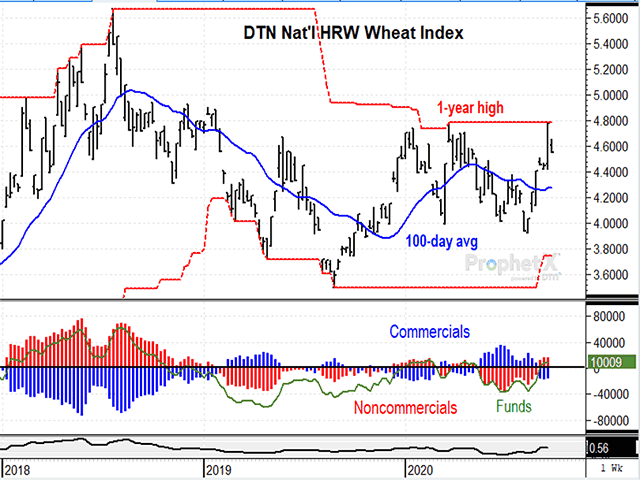Todd's Take
HRW Wheat Ignores the Bearish Talk
This will likely be remembered as the week that the hot streak of 14 consecutive soybean export sales announcements was brought to an end and combines took to fields in force across the Midwest. By Thursday afternoon (Sept. 24), November soybeans had fallen 43 1/2 cents from the previous Friday's close and turned tables on heavily bullish funds that had not been seriously challenged since early August.
It was just one week earlier that traders' attention was all over November soybeans and December corn as soybeans extended two-year highs and corn made new six-month highs. Traders were gobbling up the news of export sales like popcorn at a bad movie.
On Tuesday, Sept. 15, it looked like wheat prices weren't going to participate in the corn and soybean rallies, and December Kansas City wheat dropped 5 1/2 cents, barely managing to hold above its 100-day average. Frankly, the lackluster trade was understandable as wheat prices had been weighed down all summer by widespread expectations for a record world wheat crop and record-ending wheat stocks. There just weren't any significant production threats to be found.
Something changed on Sept. 16, however, and I suspect it was about that time traders started thinking about conditions for next year's winter wheat crops. The weather was dry in Argentina and planting conditions were said to be dry in Ukraine and Russia. Here in the U.S., the seven-day forecast was dry and traders were noticing that much of the western U.S,. where wheat is grown, was dealing with various degrees of drought.
P[L1] D[0x0] M[300x250] OOP[F] ADUNIT[] T[]
On Thursday, Sept. 17, the U.S. Seasonal Drought Outlook from the National Weather Service released a map, expecting drought to expand across the Southern Plains in the final three months of 2020. Traders responded and bid December Kansas City wheat up to a four-month high of $5.04 1/4 by Friday's close. DTN's index of cash hard red winter (HRW) wheat prices got within a penny of its one-year high at $4.79.
December Kansas City wheat prices sagged back lower this week but are staying well above the 100-day average at $4.64. Beneficial rains in the forecast for Argentina, Europe and western Ukraine are offering some reprieve from earlier concerns. It will be an interesting winter however and there is plenty of time to see how new-crop conditions develop.
The other bullish factor that has not gotten much attention is USDA's estimates of U.S. wheat stocks. Even though world wheat supplies are on track for record highs, USDA estimates HRW wheat ending supplies in the U.S. at a five-year low of 385 million bushels (mb). Soft red winter (SRW) wheat ending supplies are estimated at a six-year low of 108 mb.
Realistically, world estimates of any grain supplies are always suspect and, as I have told audiences before, I do not make trading recommendations based on estimates of world grain supplies -- they are simply not reliable enough to include in important decisions.
Many will argue that most USDA estimates are not reliable and that is why we look for supporting market factors in DTN's analysis. In this case, DTN's national HRW cash price is 26 cents below the December futures contract, which is reasonably narrow. The most bullish behavior, however, came from how cash HRW wheat prices were able to test their one-year high so easily in the face of bearish world fundamentals and with only light help from noncommercial buying. CFTC data shows 15,823 noncommercial net longs as of Sept. 15, a pretty sober market.
The current fundamental outlook for wheat prices is clearly bearish but is largely in the rear-view mirror. After eight consecutive years of higher ending world wheat stocks, it is understandable for traders to be skeptical about wheat's bullish prospects.
Looking ahead is a difficult endeavor and there are no guarantees, but HRW wheat prices should have opportunities to trade higher this winter, especially if dry concerns persist.
Todd Hultman can be reached at Todd.Hultman@dtn.com
Follow him on Twitter @ToddHultman
(c) Copyright 2020 DTN, LLC. All rights reserved.




